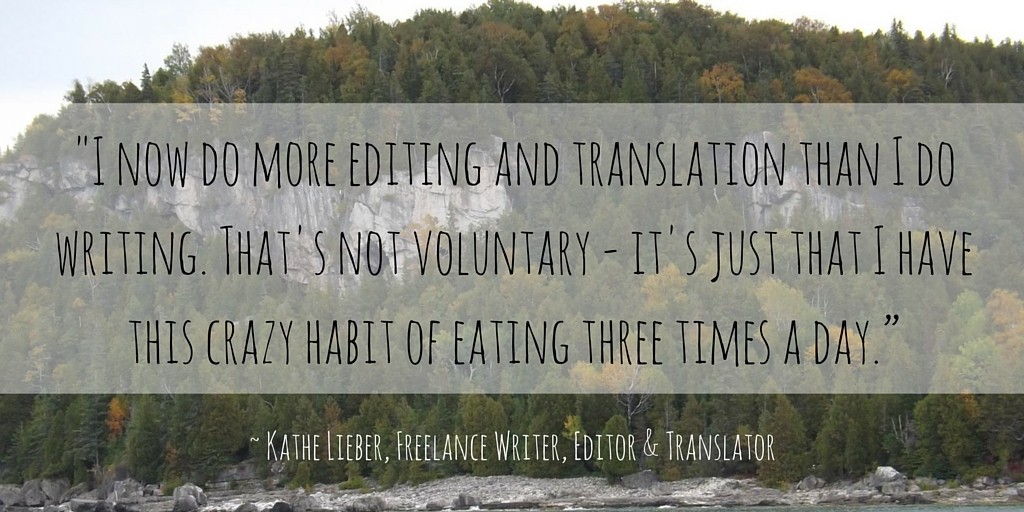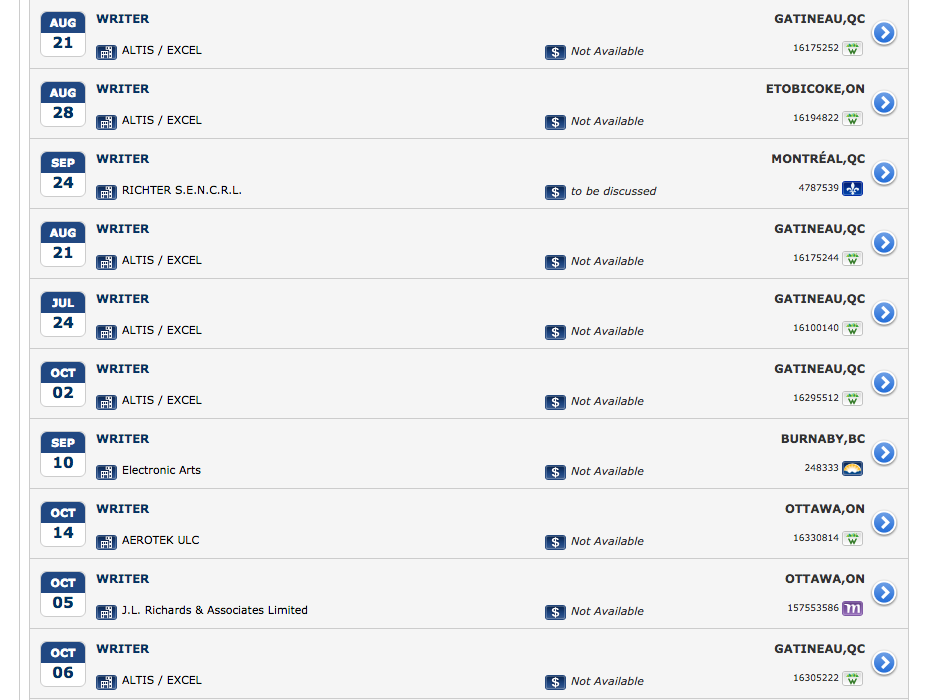Follow the Money: How to Find Clients & Structure Deals for Freelance Success
by Miranda Miller
Ah, the freelance life… lazing on the beach, trying not to tip the hammock as you reach for that one last piña colada you’ll allow yourself before settling in for your two hours of afternoon writing.
Or maybe you’re the type of freelancer who bakes all day, between keeping a spotless house and nurturing impeccable gardens, with all that time you spend at home.
Okay, time for a reality check.
So, About That…
In truth, the vast majority of people who have left the 9-5 grind in search of this idyllic freelance life have quickly learned that it’s not all sunshine and lollipops. Internet gurus promise vast riches in a 10-hour work week, but in truth, only the top 19% of American freelancers make $50,000 or more, including the 5% of freelancers smashing through the six-figure ceiling.
A recent study by Contently also tells us that the median income for freelance writers in the United States who work full-time hours at their freelance business is in the $20,000 to $30,000 bracket.
Yes, I realize we’re trying to survive in an entirely different market, north of the border. Finding Canadian figures (especially recent ones) is always challenging, but we do know that in the decade between 1995 and 2005, the average freelance writer’s income fell from $26,500 to $24,035 (PWAC). According to the 2006 census, the average freelancer’s income (classified as writers, artists and performers) was $25,451 (StatsCan).
One might even say these were the glory days of sorts for Canadian freelancers, before content farms and the erosion of copyright really took hold. That’s right — in our glory days, freelance writers in Canada were making only slightly more than enough to keep us above the poverty line.
The Current State of the Freelance Writing Industry in Canada
I asked Kathe Lieber, Montreal-based freelance writer, editor and translator, long-time PWAC member and PWAC president in 2000-2001, to have a look at the above figures, as they seem almost inconceivably low.
“Per-word rates for writers have stagnated, or gone down, since the 1980s, when I entered this profession,” Lieber explained. “The average article length is shorter too, although shorter articles often require as much research as longer ones – for less pay now.”
She continued, “The Internet, wonderful as it is in many ways, has created a climate where everyone is trying to get free ‘content’ and everyone thinks they’re a writer and will do it for ‘glory’ and ‘exposure.’ No one seems to understand the need to pay professional rates for professional research and good writing. Everything has to be done RIGHT NOW — forget accuracy and polishing your copy.”
Lieber herself is an example of the diminishing value of freelance writing in many markets. “I now do more editing and translation than I do writing. That’s not voluntary — it’s just that I have this crazy habit of eating three times a day,” she said.
The Problem with Most Freelance Opportunities
We all need to eat. I had a lot of slim days myself, particularly from around 2008 to 2012, when I was hopping from project to project, always trying to juggle anywhere from 4 to 15 clients at a time in order to survive.
By 2010, I wasn’t even doing too badly, although as a single mother, I still worked part-time jobs to provide some element of stability. Some months I sold $500 worth of writing; those were bad months. Other months saw an influx of $3000, $4000 or more, if larger projects were wrapping. Still, it wasn’t in any way reliable and overall, from 2010 to 2013, I consistently brought in about $35,000 a year as a freelance writer, after expenses.

Image credit: Bo’s Cafe Life
That’s not bad, but it’s not the best we can do, either. It was about mid-2013 when I took a critical look at just how much time I was spending sifting through garbage “Freelance Writer Wanted” ads (you know the ones: “Must have 10 years experience, topic expertise, 24-hour turnaround time, available on weekends — offering $5.00 per article to start with the possibility of more work if I like it…”), taking calls and emails only to find out an otherwise serious-sounding prospect expected me to write “for the exposure,” and all of the requisite administrative work that comes with the constant churn of finding new freelance contracts. Pitching, screening, negotiating, contract writing, chasing for payment, rinse, repeat.
It was exhausting. I was barely surviving, and I wasn’t growing my business.
A few months ago, there was a post from a young guy on the CMG Freelance listserv, The ‘Lancer. He said he’d spent two years working 6-cent-per-word gigs and was frustrated that there didn’t seem to be much else out there.
It’s a familiar refrain, especially among those who are looking in all the tradition places for freelance work: job boards, Craigslist, listing sites like Upwork, local newspaper ads, etc. Even the freelance job board for PWAC, the Professional Writers Association of Canada, where you’d expect people to be in the market for professional writers, seems to attract more cheapskates than serious buyers.
Follow the Money: Finding Clients Worth Pitching
You’ve probably heard that traditional publishing as an industry is struggling. As the Internet has democratized publishing, the big trend has been for companies and organizations to publish their own content. Most freelancers have moved beyond pitching print magazines and newspapers, at least as a full-time income source (though all the power to you if this is still working out for you), but few have really mastered the art of selling themselves to businesses.
You have to master this, though. Businesses now hold the freelance writing pursestrings.
This was really the key for me, and enabled me to crush past the $50,000 mark and then past the $100,000 mark for freelance writing services sold each year.
With that said, not all businesses are in a position to pay professional freelance writers what they’re worth, and even fewer are convinced they should, in fact, pay freelancers what they’re worth.
Because everyone is a writer now, right?
This is where it’s important to identify the types of businesses in your target market. If you’re a topic expert, you may already know the industry in which you’d like to land contracts, but here are a few other important considerations:
- Size: Often, the insulting job ads you’ll find all over the web are coming from sole proprietors, entrepreneurs, startups and small businesses. Maybe they’re just getting started; maybe they truly have no budget for content. That’s not your problem. It just takes them out of your target market. You can’t afford to spend time soliciting clients who aren’t in a position to pay you what you’re worth.
- Location: Are you restricted to working locally, by a lack of knowledge of online collaboration tools or some other factor? Are you set up to work cross-border and able to accept payments in other currencies? Are you aware of the tax implications of selling your services in other regions? Answering these questions will help you understand your geographic market, which is going to help guide your marketing efforts. Try to avoid thinking of your ideal market as “Anywhere, because I’m hungry.”
- Needs: What is that you have to offer, and how does that jive with the resources these companies already have in-house? Are you open to working with an in-house content manager (a position many sizable companies have now filled)? Are you offering editing services, as well? What programs and platforms are you comfortable in? This will help you sift through and qualify opportunities faster, and better explain the value you offer to clients.
And just where are you going to find these high value clients who fit right in the parameters of the types of companies you want to work with?
For starters, you can stop scanning jobs boards. They’re not actively looking for people like you and the sheer volume of crap you have to sift through to find one client amidst that pile of garbage negates any benefit to the time it takes you to stay on top of it.
Instead, you’re going to turn your attention to a single source: employment listings. Try the Government of Canada JobBank, for starters. Look on Monster, Indeed, and Workopolis.
But don’t look for freelance writing jobs. Those are crap, remember?
Look for writing, editing, blogging and other related jobs.
What Are Your Selling Points?
But… I don’t want a “job,” Miranda.
That’s okay. I’ll tell you a little secret: the vast majority of those companies don’t actually want to hire a full-time writer, either.
Sure, they think they do, but now that you understand this company needs written content, you’re in a great position to pitch them an alternative, based on your unique selling points. You’re the expert — you know how long it takes to produce specific types of content. Often, they just know they need someone to write things.
If you can sell companies on your services as a higher quality, lower cost alternative to having a butt in a chair 40 hours a week, you can build a reliable stable of retainer-based clients.
This is really key, because working on a retainer basis ensures that you’re available to your clients as needed, which is of value to them. But it also ensures a steady stream of freelance income for you. It’s a value exchange and business deals just don’t exist without them.
Knowing that the company needs written content, you can highlight the advantages of using a freelancer over an in-house writer:
- The company won’t need to furnish office space and provide hardware/software unless it’s part of the contract, as you are your own business.
- They won’t have to deal with payroll taxes and government remittances.
- They don’t have to pay an employee when the volume of content needed is lower, or keep someone busy if they just don’t need as much writing as they thought.
- They benefit from your professional writing experience and any topic expertise.
It’s really about figuring out what they need and packaging it as attractively as possible, with a clear selling point and value proposition for the client.
Don’t be afraid to spell it out for the client. Once you’ve evaluated what their goals are and how much writing they actually need over the course of the average month, you can make a business case for using your services:
“Rather than footing the expense of $4000-$4500 a month for a full-time, in-house writer (plus office space and equipment), it sounds like you actually just need someone reliable for 10 hours per week of on-demand writing and editing. I can offer this to your company for $3000 a month at $75/hour.”
This is the language businesspeople understand. This is how they make their buying decision.
Structuring Fair Deals with Value for Both Parties
Offering your services on a retainer basis means you guarantee your client a specific number of hours each month. You will be available to them for XX number of hours, whether it’s 10 or 20 or 40 per month. Whether or not those hours are used, you are paid that retainer amount for ensuring your availability.
They key is not to oversell a client with hours they don’t need. If they’re consistently using less than the allotted hours, they’re not going to appreciate the value they’re getting for the hours they do use. One way to combat this is to allow clients to roll unused hours over for one month, giving them an opportunity to use them the next.
You can also offer a reduced hourly rate for any hours provided over the retainer amount, to incentivize their using more of your services. You can afford to do this, because once you’re on retainer, you aren’t spending precious time sifting through ads, negotiating rates, creating contracts, etc.
This freelance strategy allows you to reduce the volume of clients you’re working with, so you can focus on meaningful, fruitful relationships with fewer clients rather than constantly chasing the next project. Getting even four or five clients on retainer can take a lot of the pressure and unpredictably out of your freelance business.
You just have to find the right clients and make the business case for your services as the most logical option.
Please share your questions or comments below!
Miranda Miller is a business and marketing writer from Owen Sound, Ontario. You can find her on Twitter at @MirandaM_EComm.







